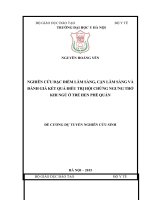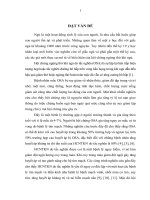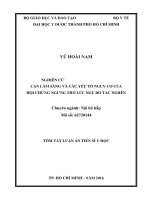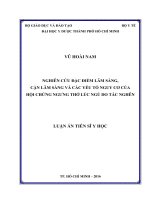Hội chứng ngưng thở khi ngủ dạng tắc nghẽn ở người có bệnh tim thiếu máu cục bộ
Bạn đang xem bản rút gọn của tài liệu. Xem và tải ngay bản đầy đủ của tài liệu tại đây (1.66 MB, 54 trang )
Reporter: Dr. Nguyen Nhat Quang
1
BACKGROUND
OSAS (Obstructive Sleep Apnea Syndrome)
Repetitive complete and/or partial collapses of
the upper airways.
2
Epidemiology
4% male–2% female
5 – 10%
Male: 4,1% - 7,5%
Female : 2,1% - 3,2%
BACKGROUND
• Negative impact on the health and quality
of life
– Drowsiness and fatigue during the day
– Neurophysiological changes
• Relating to many metabolic and cardiovascular diseases
4
BACKGROUND
hyperactivity of the sympathetic
endothelial dysfunction
atherosclerosis
systemic hypertension
Company Logo
BACKGROUND
1
Evaluate the frequency, clinical and preclinical
characterization of obstructive sleep apnea
syndrome in patients with ischemic heart
disease.
2
Survey the relationship between the apnea hyponea index and neck circumference, waist
circumference, BMI, blood pressure, blood
lipid parameters, SpO2 and Gensini score.
Diagnostic criteria
OSA = Cr A and/or Cr B + Cr C
Criteria A: excessive daytime sleepiness
Criteria B: ≥ 2 following criteria
1. Gasping and choking sensations
2. More frequent arousals
3. Insomnia
4. Daytime fatigue
5. Memory and intellectual impairment
Criteria C: AHI ≥ 5 events/h
7
The severity of OSAS
AHI (Apnea-Hyponea Index)
Mild:
AHI = 5 – 15 events/h
Moderate: AHI =16 – 30 events/h
Heavy:
AHI > 30 events/h
8
2. METHODS AND SUBJECTS
2.1. SUBJECTS
Criteria for patient selection:
≥ 50% stenosis of coronary arteries and
suspected evidence of obstructive sleep apnea
syndrome.
Cỡ mẫu thuận lợi.
OSAS (+)
Polysomnography
OSAS (-)
9
2. METHODS AND SUBJECTS
Exclusive criteria:
• Non-stenosis or stenosis <50%.
• ≥ 50% stenosis but no suspected evidence of
OSAS
• Pathological lesions in the brain such as brain
tumors, encephalitis-meningitis ...
• Chronic obstructive pulmonary disease or chronic
respiratory failure.
• Severe heart failure (EF <30%).
• Central sleep apnea syndrome.
• Not agree to collaborate with the research.
10
2. METHODS AND SUBJECTS
2.2. Time of research
02/2012 – 07/2014.
2.3. Methods
Cross-sectional descriptive study.
11
The study progress
Age
Gender
Smoking
Diabetes mellitus
1.General
characteristic
Hypertension
BMI
Neck circumference
Waist circumference
The study progress
2. Survey on clinical characteristic
Symptoms of OSAS:
Apnea (có người chứng kiến)
Loud snore (có người chứng kiến)
Gasping and/or choking sensations
Excessive daytime sleep
More frequent arousals
Insomnia
Morning headache
Memory and intellectual impairment
Blood pressure
13
The study progress
3. Survey on subclinical characteristic
3.1. Glucose, bilan lipid máu
3.2. Coronary angiography
14
Evaluate the abnormality of coronary artery
• Determine the number of coronary artery lesions:
Based on the image on the light screen.
• Determine the extent of stenosis:
0: not narrow
1: not flat vessel wall but not narrow diameter
2: no significant narrowing the diameter stenosis <50%
3: a narrow sense to narrow diameter from 50-75%
4: closed narrow when diameter stenosis > 75-95%
5: very closed narrow almost the entire diameter of > 95100%, together with congestion of contrast before
narrowing position.
6: occlusion
15
Gensini score
Score: following the extent of
Factor:
stenosis
following the lesion position
25% - 49%: 1p
50% - 74%: 2p
75% - 89%: 4p
90% - 98%: 8p
99%: 16p
Occlusion: 32p
LM: X 5
LAD1: X 2.5
LAD2: X 1.5
LCx1: X 2.5
RCA, LAD3, PLA, OM: X 1
Other branches: x 0.5
Gensini score = Total score of the number of lesions
multiplicated with the factor
16
The position of coronary lesions and
factor of lesions in accordance with Gensini score
17
TIMI SCALE
TIMI
3
2
1
0
Characteristic
The contrast flows freely and absorbed rapidly in front
of and behind the lesion of the coronary artery
The contrast is over the lesion to distal more slowly
and be ale to see the flow in the coronary artery
lumen, still fills the coronary arteries.
Only a small amount of contrast isbthrough the lesion
to the distal but not fill up the artery, slowly.
No the contrast is through the lesion to the distal of
coronary artery (occlusion or non-recovery).
18
The study progress
3.3. Polysomnography
Patients were included in the explorative room on
the appropriate time according to each patient's
habits, then they were fixed in Respironics Stardust
II of the Respironics company (Germany), including
the measuring device of SpO2, nasal airflow,
respiratory muscle pressure measuring of chest and
abdomen, snoring index, posture.
Patients will be removed the device on the next
morning when they wake up.
19
SLEEP EXPLORATION UNIT
20
STARDUST II DEVICE
21
22
POLYSOMNOGRAPHY
Determine the indexes of polysomnography:
AHI
Meaning: AHI helps diagnose and assess the
severity of OSAS
AHI fllowwing the patient’s posture, the apnea and
hypopnea form of OSAS
Mean SpO2 and lowest SpO2
The nocturnal desaturation index
Snore index
23
Statistical methods
SPSS 18.0
Medcalc 11.3.1.0
Comprehension meta analysis V2
24
3. RESULT AND DISCUSSION
25









